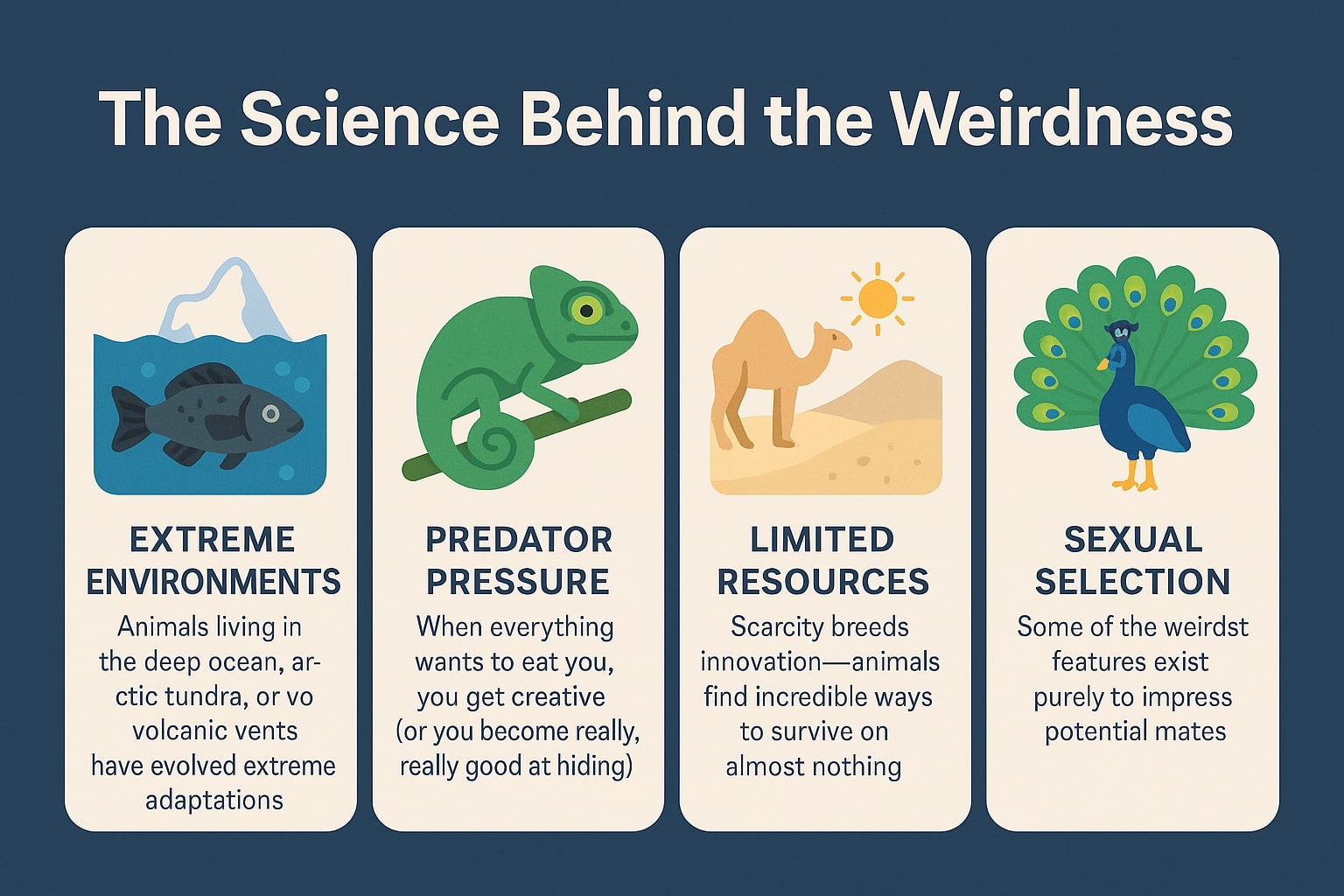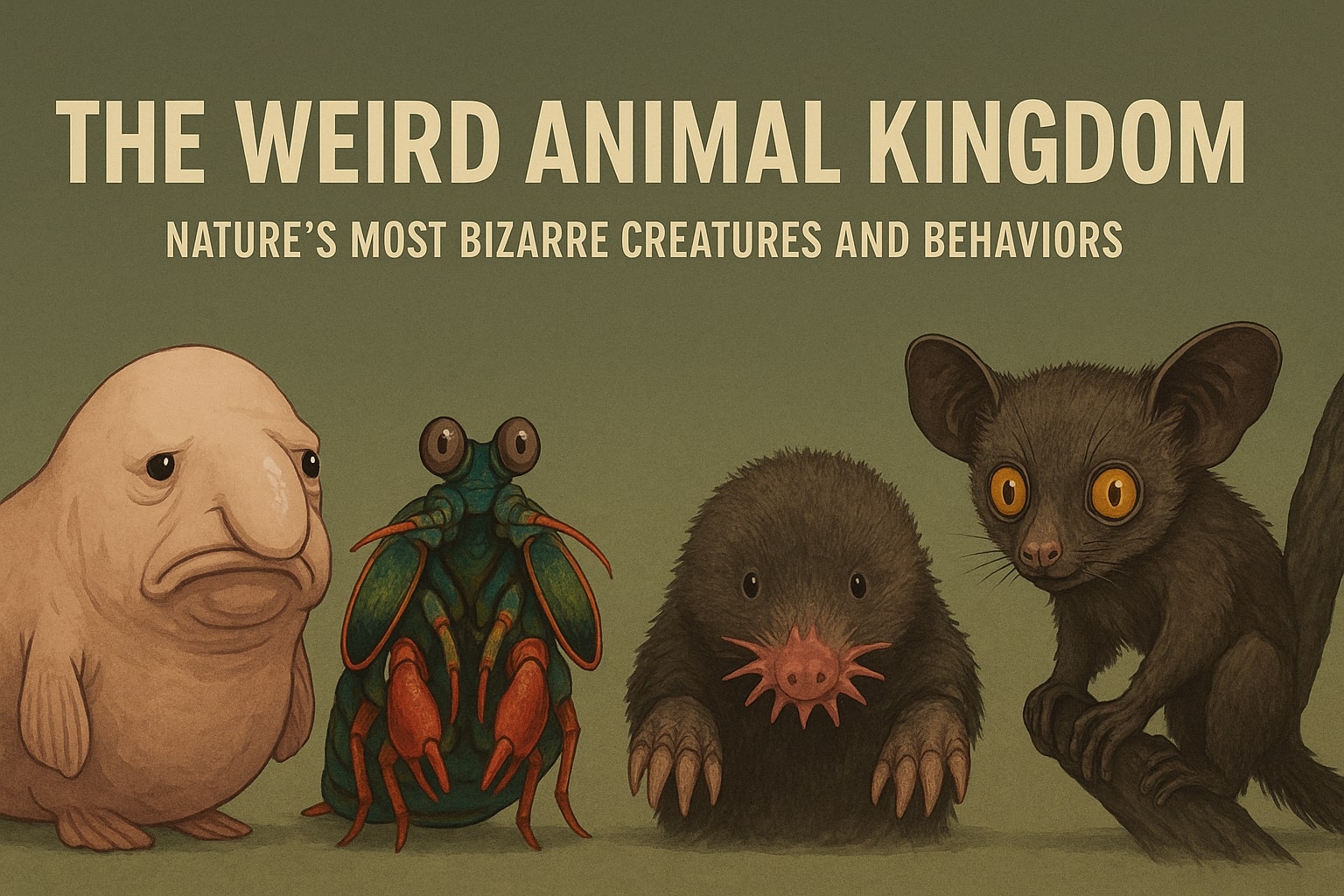The Weird Animal Kingdom: Nature's Most Bizarre Creatures and Behaviors
Nature is weird. Like, really weird. While we're busy domesticating dogs and teaching parrots to swear, the animal kingdom is out there producing creatures so bizarre they seem like they were designed by a committee of science fiction writers having a fever dream.
When Evolution Gets Creative
Evolution doesn't follow a rulebook — it's more like a mad scientist with unlimited time and resources. The result? Animals that challenge our understanding of what's possible. Our Bizarre Animals You Won't Believe Exist collection showcases creatures that seem too strange to be real, yet here they are, thriving in their own weird ways.
Take the blobfish, for example. On land, it looks like a gelatinous mess. In its natural deep-sea habitat, it's perfectly adapted to crushing pressure. The joke's on us for judging a fish out of water — literally.
The Deep Sea: Earth's Alien Planet
If you want to see truly bizarre animals, skip the zoo and dive into the deep ocean. Our planet's deepest waters are home to creatures so strange they make science fiction look conservative. Deep Sea Creatures Nobody Talks About reveals a world where:
- Fish create their own light shows
- Creatures exist without ever seeing sunlight
- Pressure would crush us instantly, but they call it home
- Size means nothing (tiny creatures eat things many times their size)
The vampire squid, despite its ominous name, is actually a gentle filter feeder. The dumbo octopus flaps its ear-like fins like underwater Dumbo. And the glass sponge forests create underwater cathedrals that have existed for thousands of years.
Behavior That Breaks the Rules
Sometimes the most mind-blowing thing about animals isn't how they look, but what they do. Weirdest Animal Behaviors Documented explores the fascinating ways animals have adapted to survive, communicate, and thrive.
Consider the dancing octopus — not just waving its arms around, but performing complex choreographed sequences to communicate with potential mates. Or the fact that some frogs literally freeze solid in winter and thaw out in spring, good as new.
The Science Behind the Weirdness

What makes these animals so bizarre isn't randomness — it's millions of years of solving very specific problems:
Extreme Environments: Animals living in the deep ocean, arctic tundra, or volcanic vents have evolved extreme adaptations
Predator Pressure: When everything wants to eat you, you get creative (or you become really, really good at hiding)
Limited Resources: Scarcity breeds innovation — animals find incredible ways to survive on almost nothing
Sexual Selection: Some of the weirdest features exist purely to impress potential mates
Why Weird Animals Matter
These bizarre creatures aren't just nature's entertainment — they're living laboratories. Scientists study extremophile animals to:
- Develop new medicines
- Understand climate adaptation
- Inspire biomimetic technology
- Expand our understanding of life's possibilities
The gecko's feet inspired better adhesives. Shark skin led to more efficient swimsuits. The bombardier beetle's chemical defense system is being studied for new propulsion technologies.
The Anthropomorphism Trap
We humans love to project our behaviors onto animals, but that's where we miss the truly amazing stuff. When we stop expecting animals to act like tiny humans and start appreciating them for what they actually are, the natural world becomes infinitely more fascinating.
A spider building a web isn't being "industrious" in a human sense — it's following millions of years of genetic programming. But that programming has produced architectural marvels that human engineers still study and admire.
Conservation Through Wonder
The weirder an animal is, the more endangered it often becomes. Strange creatures living in specific habitats are usually the first to disappear when environments change. But here's the thing — once people see how amazing these animals are, they want to protect them.
That's the power of rabbit holes like these. They transform "weird bug" into "incredible evolutionary marvel." They turn "gross deep-sea thing" into "amazing pressure-resistant engineer." Education through entertainment might be our best conservation tool.
The Endless Frontier
We've explored less than 5% of our oceans. We discover new species every day. Scientists estimate there are millions of animal species we haven't even found yet, let alone studied. Each one represents a unique solution to life's challenges, shaped by eons of trial and error.
The animals in these rabbit holes aren't just weird for the sake of being weird — they're successful. They've survived everything Earth has thrown at them, from ice ages to meteor impacts. Their "weirdness" is actually genius-level adaptation.
Embracing the Weird
Next time you see a bizarre animal video, resist the urge to immediately label it "gross" or "creepy." Instead, ask yourself: "What problem is this animal solving?" "How did it evolve to be this way?" "What can it teach us?"
The natural world is weirder, more wonderful, and more inspiring than any fiction we could create. We just need to look at it with the right eyes — preferably the compound eyes of a mantis shrimp, which can see colors we can't even imagine.
In nature's theater of the absurd, every creature is both the star and the audience.
